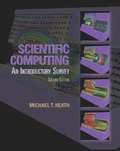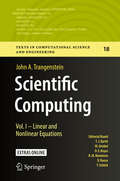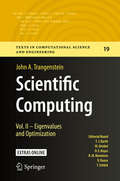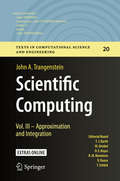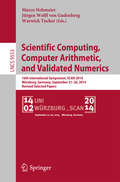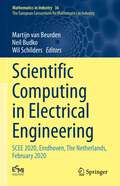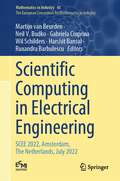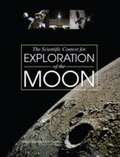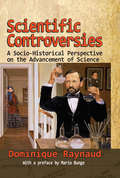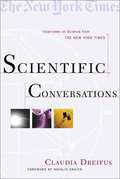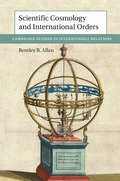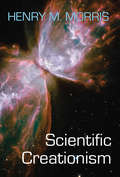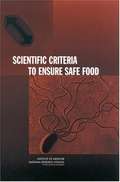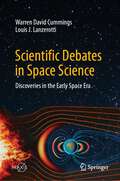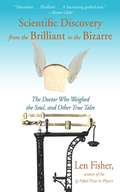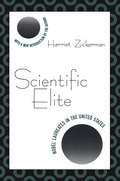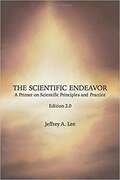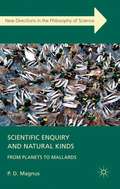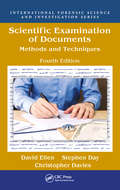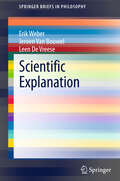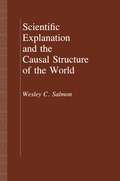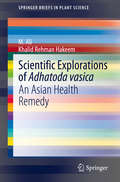- Table View
- List View
Scientific Computing: An Introductory Survey
by Michael T. HeathThis book presents a broad overview of numerical methods for solving all the major problems in scientific computing.
Scientific Computing: Eigenvalues And Optimization (Texts In Computational Science And Engineering #19)
by John A. TrangensteinThis is the first of three volumes providing a comprehensive presentation of the fundamentals of scientific computing. This volume discusses basic principles of computation, and fundamental numerical algorithms that will serve as basic tools for the subsequent two volumes. This book and its companions show how to determine the quality of computational results, and how to measure the relative efficiency of competing methods. Readers learn how to determine the maximum attainable accuracy of algorithms, and how to select the best method for computing problems. This book also discusses programming in several languages, including C++, Fortran and MATLAB. There are 80 examples, 324 exercises, 77 algorithms, 35 interactive JavaScript programs, 391 references to software programs and 4 case studies. Topics are introduced with goals, literature references and links to public software. There are descriptions of the current algorithms in LAPACK, GSLIB and MATLAB. This book could be used for an introductory course in numerical methods, for either upper level undergraduates or first year graduate students. Parts of the text could be used for specialized courses, such as principles of computer languages or numerical linear algebra.
Scientific Computing: Eigenvalues And Optimization (Texts In Computational Science And Engineering #19)
by John A. TrangensteinThis is the second of three volumes providing a comprehensive presentation of the fundamentals of scientific computing. This volume discusses more advanced topics than volume one, and is largely not a prerequisite for volume three. This book and its companions show how to determine the quality of computational results, and how to measure the relative efficiency of competing methods. Readers learn how to determine the maximum attainable accuracy of algorithms, and how to select the best method for computing problems. This book also discusses programming in several languages, including C++, Fortran and MATLAB. There are 49 examples, 110 exercises, 66 algorithms, 24 interactive JavaScript programs, 77 references to software programs and 1 case study. Topics are introduced with goals, literature references and links to public software. There are descriptions of the current algorithms in LAPACK, GSLIB and MATLAB. This book could be used for a second course in numerical methods, for either upper level undergraduates or first year graduate students. Parts of the text could be used for specialized courses, such as nonlinear optimization or iterative linear algebra.
Scientific Computing: Eigenvalues And Optimization (Texts In Computational Science And Engineering #19)
by John A. TrangensteinThis is the third of three volumes providing a comprehensive presentation of the fundamentals of scientific computing. This volume discusses topics that depend more on calculus than linear algebra, in order to prepare the reader for solving differential equations. This book and its companions show how to determine the quality of computational results, and how to measure the relative efficiency of competing methods. Readers learn how to determine the maximum attainable accuracy of algorithms, and how to select the best method for computing problems. This book also discusses programming in several languages, including C++, Fortran and MATLAB. There are 90 examples, 200 exercises, 36 algorithms, 40 interactive JavaScript programs, 91 references to software programs and 1 case study.Topics are introduced with goals, literature references and links to public software. There are descriptions of the current algorithms in GSLIB and MATLAB.This book could be used for a second course in numerical methods, for either upper level undergraduates or first year graduate students. Parts of the text could be used for specialized courses, such as nonlinear optimization or iterative linear algebra.
Scientific Computing, Computer Arithmetic, and Validated Numerics
by Marco Nehmeier Jürgen Wolff von Gudenberg Warwick TuckerThis book constitutes the refereed post proceedings of the16th International Symposium, SCAN 2014, held in Würzburg, Germany, in September 2014. The 22 full papers presented were carefullyreviewed and selected from 60 submissions. The main concerns of research addressed by SCAN conferences are validation, verification or reliable assertions of numerical computations. Interval arithmetic and other treatments of uncertainty are developed as appropriate tools.
Scientific Computing in Electrical Engineering: SCEE 2020, Eindhoven, The Netherlands, February 2020 (Mathematics in Industry #36)
by Martijn Van Beurden Neil Budko Wil SchildersThe conference has an interdisciplinary focus and aims to bring together scientists – mathematicians, electrical engineers, computer scientists, and physicists, from universities and industry – to have in-depth discussions of the latest scientific results in Computational Science and Engineering relevant to Electrical Engineering and to stimulate and inspire active participation of young researchers.
Scientific Computing in Electrical Engineering: SCEE 2022, Amsterdam, The Netherlands, July 2022 (Mathematics in Industry #43)
by Martijn Van Beurden Neil V. Budko Gabriela Ciuprina Wil Schilders Harshit Bansal Ruxandra BarbulescuThis volume comprises selected papers presented at the 14th International Conference on Scientific Computing in Electrical Engineering, SCEE 2022, held in Amsterdam, The Netherlands, in July 2022. The aim of the SCEE 2022 conference was to bring together scientists – mathematicians, electrical engineers, computer scientists, and physicists, from universities and industry – to have in-depth discussions of the latest scientific results in Computational Science and Engineering relevant to Electrical Engineering and to stimulate and inspire active participation of young researchers.This extensive reference work is divided into four parts: Part I Circuit Simulation and Design.- Part II Device Simulation.- Part III Computational Electromagnetics.- Part IV Mathematical and Computational Methods. Each part starts with a general introduction, followed by the respective contributions. The book will appeal to mathematicians and electricalengineers. Further, it introduces algorithm and program developers to recent advances in the other fields, while industry experts will be introduced to new programming tools and mathematical methods.
The Scientific Context for EXPLORATION of the MOON
by National Research Council of the National AcademiesBecause of the Moon’s unique place in the evolution of rocky worlds, it is a prime focus of NASA’s space exploration vision. Currently NASA is defining and implementing a series of robotic orbital and landed missions to the Moon as the initial phase of this vision. To realize the benefits of this activity, NASA needs a comprehensive, well-validated, and prioritized set of scientific research objectives. To help establish those objectives, NASA asked the NRC to provide guidance on the scientific challenges and opportunities enabled by sustained robotic and human exploration of the Moon during the period 2008-2023 and beyond. This final report presents a review of the current understanding of the early earth and moon; the identification of key science concepts and goals for moon exploration; an assessment of implementation options; and a set of prioritized lunar science concepts, goals, and recommendations. An interim report was released in September 2006.
The Scientific Context for Exploration of the Moon--Interim Report
by National Research Council of the National AcademiesBecause of the Moon's unique place in the evolution of rocky worlds, it is a prime focus of NASA's space exploration vision. Currently NASA is defining and implementing a series of robotic orbital and landed missions to the Moon as the initial phase of this vision. To realize the benefits of this activity, NASA needs a comprehensive, well-validated, and prioritized set of scientific research objectives. To help establish those objective, NASA asked the NRC to provide guidance on the scientific challenges and opportunities enabled by sustained robotic and human exploration of the Moon during the period 2008-2013+. This interim report, which focuses on science of the Moon, presents a number of scientific themes describing broad scientific goals important for lunar research, discussions of how best to reach these goals, a set of three priority areas that follow from the themes, and recommendations for these priorities and related areas. A final report will follow in the summer of 2007.
Scientific Controversies: A Socio-Historical Perspective on the Advancement of Science
by Dominique Raynaud Mario BungeIn Scientific Controversies, Dominque Raynaud shows how organized debates in the sciences help us establish or verify our knowledge of the world. If debates focus on form, scientific controversies are akin to public debates that can be understood within the framework of theories of conflict. If they focus on content, then such controversies have to do with a specific activity and address the nature of science itself. Understanding the major focus of a scientific controversy is a first step toward understanding these debates and assessing their merits.Controversies of unique socio-historic context, disciplines, and characteristics are examined: Pasteur's germ theory and Pouchet's theory of spontaneous generation; vitalism advocated at Montpellier versus experimental medicine in Paris; the science of optics about the propagation of visual rays; the origins of relativism (the Duhem-Quine problem). Touching on the work of Boudon, Popper, and others, Raynaud puts forward an incrementalist theory about the advancement of science through scientific controversies.The debates Raynaud has selected share in common their pivotal importance to the history of the sciences. By understanding the role of controversy, we better understand the functioning of science and the stakes of the contemporary scientific debates.
Scientific Conversations: Interviews on Science from the New York Times
by Claudia DreifusDr. Benjamin Carson, a pediatric neurosurgeon, describes what it feels like to dig around in someone's brain. Dr. Leon Lederman, Nobel laureate, displays the wry humor that has earned him the title :the Mel Brooks of the physics world. : Pulitzer Prize-winning author John McPhee reveals how he cam to terms with the vastness of geological time and that he once tied himself to a chair in order to write. Ira Flatow, host of National Public Radio's Science Friday, recalls how his childhood fascination with electrical outlets almost caused him to blow up his mother's bathroom. Astronomer Royal Sir Martin Rees discloses his astrological sign. In these thirty-eight interviews, originally published in the weekly Science Times section of The New York Times, Claudia Dreifus brings all of her colorful personality to bear on her subjects, as well as an arsenal of philosophy, literature, current events, and an unmistakable curiosity. As each conversation unfolds, we learn surprising and fascinating things about some of the most intriguing figures and issues in science today. Dreifus's outsider status in the world of science is perhaps one of her greatest interviewing strengths. A political journalist for much of her career, she stumbled into a position at the Science Times. With little more scientific background that the average person, she scrambled to prepare for her meetings with some of the greatest minds across a broad range of disciplines-from astronomy to geology, from biology and medicine to computer science and mathematics. She soon found herself in a refreshingly candid environment, so unlike the one she had known on the political beat. It is from this perspective that she makes science tangible, accessible, and entertaining. When you add a deep-rooted scientific curiosity to the savvy of a crack political reporter, you get more than just extraordinary chemistry: Claudia Dreifus reminds us that interviewing can be an art form.
Scientific Cosmology and International Orders (Cambridge Studies In International Relations #147)
by Bentley B. AllanScientific Cosmology and International Orders shows how scientific ideas have transformed international politics since 1550. <P><P>Allan argues that cosmological concepts arising from Western science made possible the shift from a sixteenth century order premised upon divine providence to the present order centred on economic growth. As states and other international associations used scientific ideas to solve problems, they slowly reconfigured ideas about how the world works, humanity's place in the universe, and the meaning of progress. <P>The book demonstrates the rise of scientific ideas across three cases: natural philosophy in balance of power politics, 1550–1815; geology and Darwinism in British colonial policy and international colonial orders, 1860–1950; and cybernetic-systems thinking and economics in the World Bank and American liberal order, 1945–2015. Together, the cases trace the emergence of economic growth as a central end of states from its origins in colonial doctrines of development and balance of power thinking about improvement.<P> Outlines how scientific ideas have shaped international politics.<P> Reveals the far-reaching power and influence of the natural and social sciences on international politics.<P> Presents a new macrohistorical narrative of the development of the international system.<P>
Scientific Creationism
by Dr Henry M. MorrisThe story of the origin of all things: Does the scientific evidence support special creation or atheistic evolution? Authoritative and thoroughly documented, Scientific Creationism is easily understood by readers with non-scientific backgrounds. Teachers, students, pastors, and other witnessing Christians can now be equipped with the convincing evidence for special creation. Updated and expanded, Scientific Creationism is a book that has changed the lives of people for Christ - people who have been blinded by the current origin-myth, evolution. "All ministers of the gospel, teachers and professors of our Christian schools on the primary and secondary level, should read this book. A copy should be placed in every church and school library, and used as a textbook in our Christian high schools and colleges."-Rev. C. Van Schouwen
Scientific Criteria to Ensure Safe Food
by National Research CouncilFood safety regulators face a daunting task: crafting food safety performance standards and systems that continue in the tradition of using the best available science to protect the health of the American public, while working within an increasingly antiquated and fragmented regulatory framework. Current food safety standards have been set over a period of years and under diverse circumstances, based on a host of scientific, legal, and practical constraints. Scientific Criteria to Ensure Safe Food lays the groundwork for creating new regulations that are consistent, reliable, and ensure the best protection for the health of American consumers. This book addresses the biggest concerns in food safety—including microbial disease surveillance plans, tools for establishing food safety criteria, and issues specific to meat, dairy, poultry, seafood, and produce. It provides a candid analysis of the problems with the current system, and outlines the major components of the task at hand: creating workable, streamlined food safety standards and practices.
Scientific Debates in Space Science: Discoveries in the Early Space Era (Springer Praxis Books)
by Warren David Cummings Louis J. LanzerottiThis book features several of the significant scientific debates and controversies that helped develop space science in the early space era. The debates led to significant new understandings of the constituents and processes occurring beyond Earth’s atmosphere, and often opened new research directions. Scientific speculations with their resultant debates have played an important role in the development and furthering of research in general. The book thus has broad intellectual importance in illustrating how science advances.The book includes debates in the subject areas of heliophysics (physics in the cosmic region that covers particles and magnetic fields flowing from the Sun), Earth’s moon, solar system asteroids and comets, and the origin of cosmic gamma-ray bursts. A final chapter describes two important and surprising early scientific discoveries that involved no debates. The target audience for this book includes (a) active and retired space scientists, (b) space enthusiasts, and (c) students as supplemental (or even prime) reading in an introductory astronomy and/or space science course. The topics of the debates and controversies, their resolutions, and their pointing to further research and understanding of nature are of both historical and contemporary interest, appeal, and value.
Scientific Discovery from the Brilliant to the Bizarre: The Doctor Who Weighed the Soul, and Other True Tales
by Len FisherWinner of the IgNobel Prize in physics and the 2004 American Institute of Physics Science Writing Award, Len Fisher showed just how much fun science can be in his enthusiastically praised debut, How to Dunk a Doughnut. In this new work, he reveals that science sometimes takes a path through the ridiculous and the bizarre to discover that Nature often simply does not follow common sense. One experiment, involving a bed, platform scales, and a dying man, seemed to prove that the soul weighed the same as a slice of bread. But other, no less fanciful experiments and ideas led to the fundamentals of our understanding of movement, heat, light, and energy, and such things as the discovery of electricity, and the structure of DNA; improved engines; and the invention of computers. As in his previous book, Fisher uses personal stories and examples from everyday life, as well as humor, to make the science accessible. He touches on topics from lightning to corsets and from alchemy to Frankenstein and water babies, but he may not claim the last word on the weight of the soul!
Scientific Elite: Nobel Laureates in the United States
by Harriet ZuckermanScientific Elite is about Nobel prize winners and the well-defined stratification system in twentieth-century science. It tracks the careers of all American laureates who won prizes from 1907 until 1972, examining the complex interplay of merit and privilege at each stage of their scientific lives and the creation of the ultra-elite in science.The study draws on biographical and bibliographical data on laureates who did their prize-winning research in the United States, and on detailed interviews with forty-one of the fifty-six laureates living in the United States at the time the study was done. Zuckerman finds laureates being successively advantaged as time passes. These advantages are producing growing disparities between the elite and other scientists both in performance and in rewards, which create and maintain a sharply graded stratification system.
The Scientific Endeavor: A Primer on Scientific Principles and Practice
by Jeffrey Lee"The Scientific Endeavor" is an introduction to what science is and how it is done. Many college courses are good at presenting particular disciplines (Biology, Chemistry, etc.), but not the details of science itself. Science literacy for educated citizens and for professional scientists requires an understanding of science itself. Written at an introductory college level, this book provides on overview of what science is, the philosophy of science, how research is done, how scientists interact, ethics and misconduct, scientific thinking, and pseudoscience. It has been used as a supplementary textbook in introductory science classes, as the main text in classes about science, and as background reading to spark discussions in advanced undergraduate and graduate courses.
Scientific Enquiry and Natural Kinds
by P. D. MagnusSome scientific categories seem to correspond to genuine features of the world and are indispensable for successful science in some domain; in short, they are natural kinds . This book gives a general account of what it is to be a natural kind and puts the account to work illuminating numerous specific examples.
Scientific Examination of Documents: Methods and Techniques, Fourth Edition (International Forensic Science And Investigation Ser.)
by David Ellen Stephen Day Christopher DaviesRevised and expanded to reflect the most recent innovations in the field, The Scientific Examination of Documents, Fourth Edition is a handy, accessible volume detailing current best-practices for forensic document examination. Since the first edition published in 1989, there have been drastic changes in the field of forensic document examination—both from the use of the analytic techniques available to the professional examiner—and the changes to technology in office and printing equipment and inks. The purpose of analyzing any material used in the production of a questioned document, such as an ink or a piece of paper, is to compare it with another material elsewhere in the questioned document itself—or on another document—to determine whether or not they share a common origin. There may also be a need to provide information for the investigator about the possible origins of the document. This latest edition reflects the myriad changes and advances that have occurred in the last 10 to 15 years. Topics covered include: current thinking on handwriting interpretation; accidental and deliberate modification of handwriting; the proper collection of samples; a discussion of shredded documents; professional accreditation standards, qualifications, and training; and modern digital imaging and analysis of documents and handwriting utilizing software and imaging, including reconstruction of an image from erasures, obliteration and other document altering methods. A new section addresses cognitive bias and Chapter 8 is completely updated to cover the advances in print and photocopied documents, based on current technology, and analytical developments in the comparison of such documents. Key features: Discusses issues regarding handwritten, photocopied, and printed documents—including inkjet versus digital printing Presents the advances and capabilities modern office fax, photocopy, and printing technologies—and implications for document examination Details and reinforces the importance of ensuring proper scientific methods during an examination Addresses current Raman spectroscopy, UV-VIS, mass spectroscopy, and SEM analysis techniques Highlights the importance, and implications, of biological and fingerprint evidence from documents that can be collected, examined, and utilized in a case The Scientific Examination of Documents, Fourth Edition serves as an invaluable resource to established professionals, those just entering the field, and legal and investigative professionals outside the discipline who have a professional interest dealing with questioned documents in the course of their work.
Scientific Explanation
by Jeroen Van Bouwel Leen De Vreese Erik WeberWhen scientist investigate why things happen, they aim at giving an explanation. But what does a scientific explanation look like? In the first chapter (Theories of Scientific Explanation) of this book, the milestones in the debate on how to characterize scientific explanations are exposed. The second chapter (How to Study Scientific Explanation?) scrutinizes the working-method of three important philosophers of explanation, Carl Hempel, Philip Kitcher and Wesley Salmon and shows what went wrong. Next, it is the responsibility of current philosophers of explanation to go on where Hempel, Kitcher and Salmon failed. However, we should go on in a clever way. We call this clever way the pragmatic approach to scientific explanation and clarify briefly what this approach consists in. The third chapter (A Toolbox for Describing and Evaluating Explanatory Practices) elaborates the pragmatic approach by presenting a toolbox for analysing scientific explanation. In the last chapter (Examples of Descriptions and Evaluations of Explanatory Practices) the approach is illustrated with real-life examples of scientists aiming at explaining. This book can be used as a textbook for intermediate philosophy of science courses and is also valuable as "suggested reading" for introductory courses in philosophy of science. The way the book is set up makes it an excellent study and research guide for advanced (MA and PhD) students that work on the topic of scientific explanation. Finally, it is a handy source and reference book for senior researchers in the field of scientific explanations and - more generally - for all philosophers of science.
Scientific Explanation and the Causal Structure of the World
by Wesley C. SalmonThe philosophical theory of scientific explanation proposed here involves a radically new treatment of causality that accords with the pervasively statistical character of contemporary science. Wesley C. Salmon describes three fundamental conceptions of scientific explanation--the epistemic, modal, and ontic. He argues that the prevailing view (a version of the epistemic conception) is untenable and that the modal conception is scientifically out-dated. Significantly revising aspects of his earlier work, he defends a causal/mechanical theory that is a version of the ontic conception. Professor Salmon's theory furnishes a robust argument for scientific realism akin to the argument that convinced twentieth-century physical scientists of the existence of atoms and molecules. To do justice to such notions as irreducibly statistical laws and statistical explanation, he offers a novel account of physical randomness. The transition from the "reviewed view" of scientific explanation (that explanations are arguments) to the causal/mechanical model requires fundamental rethinking of basic explanatory concepts.
The Scientific Exploration of Venus
by Fredric W. TaylorVenus is the brightest 'star' in the night sky and it has been observed since ancient times. Often dubbed Earth's 'twin', it is the planet most similar to the Earth in size, mass and composition. There the similarity ends: Venus is shrouded by a dense carbon dioxide atmosphere, its surface is dominated by thousands of volcanoes and it lacks a protective magnetic field to shield it from energetic solar particles. So why isn't Venus more like Earth? In this book, a leading researcher of Venus addresses this question by explaining what we know through our investigations of the planet. Venus presents an intriguing case study for planetary astronomers and atmospheric scientists, especially in light of the current challenges of global warming, which supports, and potentially threatens, life on Earth. Scientifically rigorous, yet written in a friendly non-technical style, this is a broad introduction for students, and astronomy and space enthusiasts.
Scientific Explorations of Adhatoda vasica: An Asian Health Remedy (SpringerBriefs in Plant Science)
by M. Ali Khalid Rehman HakeemNatural remedies play an important role in curing ailments that happen by chance or adoptively. Adhatoda vasica is a natural Asian remedy that has the potential to treat respiratory disorders, among others. While existing literature does exist on this medicinal plant, it can be cumbersome to sort through for information relevant to academics, research, and practice. This work reframes and consolidates information on Adhatoda vasica so that it is easier to approach through academic, research, and practitioner perspectives.
Scientific Foundations of Engineering
by Mcknight Stephen W. Christos ZahopoulosProviding an overview of the foundations of engineering from a fundamental scientific and physical perspective, this book reinforces the basic scientific and mathematical principles which underpin a range of engineering disciplines and applications. It covers the basics of physics, including quantum physics, as well as some key topics in chemistry, making it a valuable resource for both students and professionals looking to gain a more coherent and interdisciplinary understanding of engineering systems. Throughout, the focus is on common features of physical systems (such as mechanical and electronic resonance), showing how the same underlying principles apply to different disciplines. Problems are provided at the end of each chapter including conceptual questions and examples to demonstrate the practical application of fundamental scientific principles. These include real-world examples, which are solvable using computational packages such as MATLAB.
